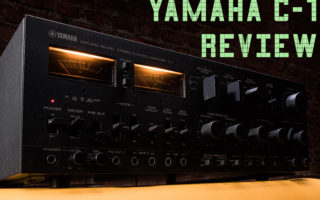
This is yet another V-FET amplifier review. A pre-amplifier, to be more precise. The only V-FET pre-amplifier ever built and supposedly one of the best pre-amps, full stop. These pre-amps are rather rare and can get quite pricey, even the pieces that don’t work or the ones listed on ebay as “not tested”, which is a code name for “tested and not working” most of the time.
This one was listed as “not working” and cost me about £1500, which is quite a lot for something that’s not actually working. But I took a leap of faith and bought her anyway, wishing the V-FET transistors are alright. Luckily, there was just something wrong with the power supply which has been repaired and to be sure it’s going to last at least next fifty years I’ve got it completely restored to its former glory. The most important part of this pre-amp are of course the V-FET transistors. The problem is the transistors used in this pre-amp were made exclusively for this pre-amp alone. They are no longer produced and if some of them were to blow up, it would to be a bloody pricey repair.
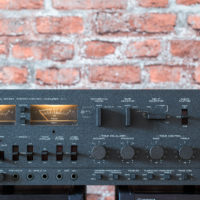
V-FET
Now I’m about to repeat myself, so if you watched or read some of my previous V-FET reviews, you can skip this bit. V-FET or SIT or Power FET transistors were developed by Nishizawa Jun-ichi, known as Mr. Semiconductor, and rightly so, not only he was pretty good at his job, he was so obsessed with his work, he was actually thinking about naming his son after a transistor. And as him being Japanese, there were only Japanese companies utilising V-FETs in their products. Yamaha, Victor, known as JVC outside of Japan, Sansui, SONY and Hitachi. Unlike Yamaha, JVC and Sansui, Hitachi and SONY also produced Integrated Amplifiers with the V-FET transistors.
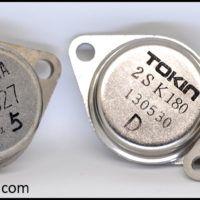
V-FETs have got very low noise, very low distortion and short turn-on and turn-off times. They say the V-FET is as close to triodes as transistor will get. And from what I’ve heard so far, it’s true. These transistors produce warm and sweet sound, but unlike the valve amps, the sound is also crystal clear and detailed. I hate to repeat myself, but these really are one of the best amps, full stop. Either new or old, you can hardly find anything better than the V-FET. The production ran only for couple of years, before everybody turned their backs on the V-FETs and started using much cheaper and easier to work with MOS-FETs and BJTs. The V-FETs can get quite hot compared to other transistors and need very precise and flawless power supply, otherwise they may quite easily end up dead.
Pre-amplifier / Control amplifier
There are basically two types of amplifiers, power amps and pre-amps. Power amps take care of the amplification of the signal, while the pre-amps are there for volume and tone control, additional inputs and outputs and slight signal pre amplification. You may have heard saying “there’s no pre-amp like no pre-amp” and I always thought so too. Up till now, I’ve been using Sony TA-E88 connected to my Yamaha B-3s and the sound is exactly the same with or without the pre-amp. I wonder if that’s going to be the case with the C-1 as well. Surely there are crappy pre-amps that cock up the sound, there are also good pre-amps that don’t worsen the sound such as the TA-E88 and there are supposed to be brilliant pre-amps that even make the sound better in terms of soundstage or whatever. And since the C-1 is supposed to be one of the best pre-amps there is, I hope she’s going to prove that saying wrong.
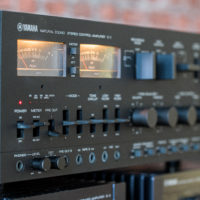
Brief history
Yamaha is one of the first companies that utilised the V-FET transistors in their products. And the only company that used the V-FET transistors in the pre-amp. Yamaha is certainly proud of the C-1 they even put her on the history page of their web site. The C-1 was released in 1975 to be paired with her power amp sister the B-1 which was released a year earlier. Unfortunately, I haven’t got the B-1…yet…so, I can’t test this monster combo. The C-1 was Yamaha’s top of the line pre-amp and cost 400 000 yen which is about $10 000 in today’s currency and if you paired her with the B-1 which cost about the same you could have had a very nice second hand car instead.
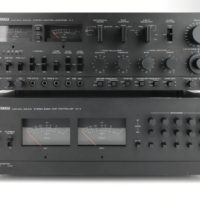
Design
You can’t….. you can’t not love her, just look at her she’s absolutely stunning. And in the silver finish…….bloody hell. Yamaha made the silver version in very limited numbers and only for chosen markets. Nevertheless, I’d switch my black version for the silver one any time. I know it’s a stupid rectangle, but the buttons, knobs, power meters and all the writings make her utterly gorgeous. And if you pair her with her B-1 sister, it’s a couple to die for. The C-1 is chock-a-block with electronics, knobs, switches and buttons and she’s probably the only Yamaha’s pre-amp with power meters. As she was made in the 70’, the backlight is made of a simple small light bulb placed above the meters, I fancy it a tad more than today’s LED back lights.
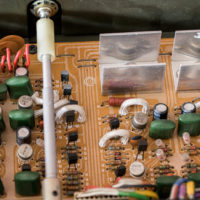
Speaking of LEDs, these light up when you turn on some of these switches, it’s a nice touch, like this you know right away, if some tone controls are used or not. She’s not too heavy, she weights 38lbs, which is about 17kg, unlike the B-1 which weights three times as much.
Build quality
Every bit of this pre-amp is well built. All switches and buttons click like new (at least it feels like it), knobs turn firmly, nothing wiggles or rattles or feels knackered. VU meters still work perfectly fine and the entire chassis feels firm, solid and tough. Yamaha did a cracking job on this one for sure.
Features
The power switch turns on the amp, obviously, it lights up the power meters and after you hear the familiar relay click, you can start using the pre-amp. The meter switch controls the power meters, whether they display what’s coming out of the pre-amp or what’s going in the REC terminals. You can also choose which pre out terminal to use. Mode switches control channels, either stereo, mono, reverse, etc. nine modes in total. Tone circuit enables tone control and tone equaliser functions which enable you to control bass, treble, acoustic, presence and turnover frequencies. I never use these features myself but for the sake of this review I had to test it, of course, and found out the differences are very subtle. If you fancy overbassed or overtrebled music, you won’t get it using the C-1. The volume knob is pretty much self-explanatory. Another feature that needs tone circuit to be enabled is loudness. Yamaha recommends in the manual to set the volume to normal listening levels and if needed, reduce the level using loudness rather than the volume knob itself. Using the volume lowers the volume level, but the loudness behaves a little bit differently. When it’s all the way to the right the frequency response is flat, turning the knob left lowers the mid frequencies the most while keeping the heights and the lows at higher levels.The balance knob is placed around the loudness knob and I quite fancy how it’s designed. The audio muting switch either cuts off the output completely or lowers it by 20dB. Input selector switch, besides the usual inputs has got one interesting feature. Using the test position is for generating couple of test frequencies to test various components, which is then controlled by the OSC knob. What is a tad disappointing though, is that the phono stage is just for MM cartridges, so if you want to listen to an MC cartridge, you need to get an additional head amp. On the flip side, if you’ve got MM cartridges, you can connect up to three turntables and you’ve got quite large and precise options for adjusting impedance. Next one is not exactly a feature it may be useful though. She runs so bloody hot, it’s excellent for winter times, you don’t need any heaters, but in the summer, it may be a bit of a problem for both, you and the amp. The hottest bit is here where the vents are, obviously. The temperature is of course even higher inside. As I said before, she’s littered with electronics, there are tuns of PCBs, some moving parts and other odds and sods. I saw her completely taken apart and she’s not exactly empty.
Rear panel
There are tons of input terminals. Three phono inputs, tuner, two auxiliary and three tape inputs, that’s more than enough for most people. Tuner, auxiliary and tape inputs are practically the same thing, so it doesn’t matter where you put your DAC, tape deck or reel to reel deck, etc. Pre out is, of course, output leading to the power amp. With meter input, you can use power meters to measure an external source, instead of the signal coming into the normal input terminals. Level adjust knobs are there for adjusting the level of the signal from all these sources. This bit is for connecting an external equipment for testing purposes using the internal oscillator as I showed before. With this connector you can connect the C-1 and the B-1 together with a special cable. You can then turn on and off the B-1 by turning on and off the C-1, nothing else.

Sound
Well, I played around with her for about a fortnight to find out if she’s actually worth it. I don’t know what I expected but to be perfectly honest, I actually got a better sound. Sure, it can be a placebo to justify a very steep price of these devices, but I believe I actually heard the difference. I tested the pre-amp on two very different systems, mine and my mate’s. My setup is two Yamaha B-3s in BTL mode powering two Infinity Kappa 9.2 speakers and my mate’s setup is Accuphase A-65 and some custom made loudspeakers. I don’t want to spew some audiophile rubbish but the C-1 enhanced the sound in two ways. A better instrument separation and better and more pronounced details. Since I wasn’t sure if it just my imagination or not, I had my mate come over and listen to the C-1 and made him assess the sound if he can hear any difference whatsoever. And his assessment was very similar to mine, we agreed on that. The last thing I’ve noticed after these fourteen days is that the sound is somehow less tiring. Don’t get me wrong the sound that’s coming out of the B-3 is nearly perfect, it’s not tiring at all, but after I connected them to the C-1 it made it somehow even less so. The sound seems a bit softer, like it’s caressing your eardrums. If you want to use an MM cartridge the C-1 does an outstanding job getting the best possible sound out of the cartridge.
Preamps in general increase gain and thus they slightly increase noise floor, so I was wondering, how much noise the C-1 adds to the signal. This is the ADC’s noise floor, I don’t know what the spike is, but it’s not important for this test. And this is the C-1’s noise floor. It adds about 10dB across the frequency board. Human hearing threshold is about -115dB, so any noise that’s coming out of the C-1 is inaudible. Even though this looks more like a distortion, than a noise.
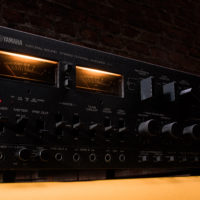
Conclusion
Yamaha aimed quite high, they wanted to create the best solid state amp combo and it seems like they did a bloody good job creating these beasts. Unfortunately, the B-1 I’ve got has the transistors burnt, so I can’t test her yet. But I’ve got the C-1 connected to my B-3s which are simply astonishing piece of hardware. So, if this is one of the best pre-amps there is, is she worth the money? I’ve bought mine for £1500 which is a bloody good price for a working piece, even though she was advertised as “not working”, plus another £500 for the restoration. You can find working C-1 for $5000 online which is not exactly cheap.
She makes the sound undoubtedly better, it’s subtle, it’s not like 5 levels better, but it’s there. The supposedly best pre-amp for £2000 is a steal considering you can also get second hand Accuphase C-3900 for about £18 000. I haven’t heard, let alone tested the C-3900 but considering the price and that the C-1 is considered one of the best pre-amps, why would anybody buy that overpriced crap? When I A/B compared my B-3s to top Accuphase power amps A-65 and P-7100, the B3s were just better and that makes me believe the C-1 is better as well. Nevertheless, I’ve compared the C-1 to my Sony TA-E88, and the C-1 is surely better in terms of sound quality and features. Sony wasn’t bad, she added some controls and inputs for the various audio equipment but what’s more important, she didn’t degrade the sound in any way, but also didn’t enhance it the way the C-1 did. If I had to pay $5000 for this or any pre-amp for that matter, I’d certainly skip it, the price is bollocks for what the pre-amp does.
I’m not sure if this kind of difference in sound justifies the high price, but I’m keeping her anyways, at least until I find something better, if something better exists. Perhaps upgrading your power amp, DAC or treating your room would be a better choice, however, if you believe that all your equipment is top of the line and you can’t upgrade anything anymore and you don’t care about the price, the C-1 is a way to go.
